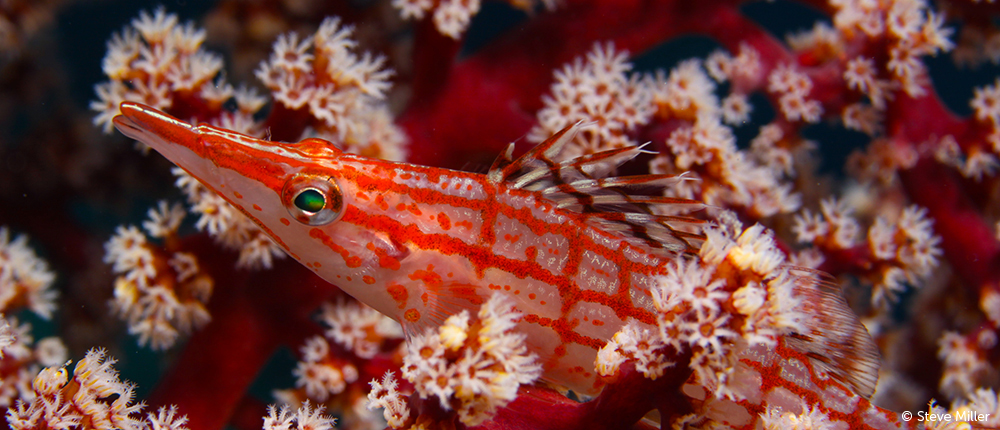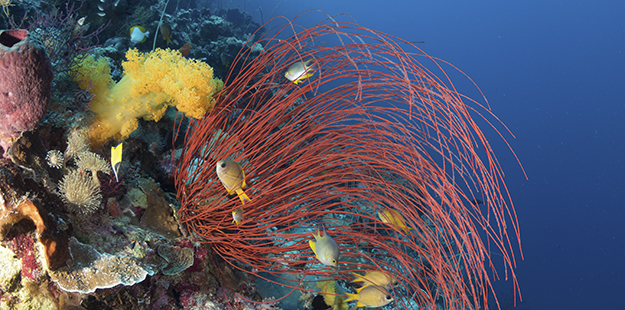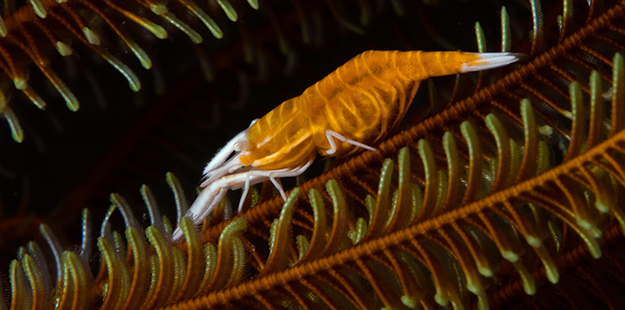Life on a Limb
Discovering the menagerie of small creatures living on sea fans
At Wakatobi dive sites such as Fan 38, the profusion of colorful soft corals may inspire you to back up and take in the big picture. But after doing so, you might want to move in among the luxuriant groves of sea fans and whips that carpet the slopes and walls. Well, maybe grove isn’t the right word, since these organisms are actually animals known as gorgonians, aka sea fans. But technicalities aside, the branch-like tentacles and leaf-like appendages of sea whips and sea fans do have one thing in common with a terrestrial forest: they provide habitat and shelter for a menagerie of small creatures. Next time you come across a sun-dappled collection of fans or whips on a Wakatobi reef, look close, and you may be surprised at what you discover.
Staking out a stalk
The twisting and spiraling stalks of a sea whip might not seem like a good place to call home, as they don’t offer much in the way of concealment or shelter. But there is one fish in particular that has adapted to blend in perfectly among the spiky-textured tentacles. At around 4 cm in length, the whip coral goby would be relatively easy to find, were it not for a coloration that makes it almost invisible. The goby’s body is partially translucent, while the visible areas match the hues and patterns of the whip. These gobies hang close to their sheltering branch, nabbing the occasional invertebrate or dollop of zooplankton that drifts past. They may be found singly or in pairs, and once you know what you are looking for, you’ll find they are quite common in Wakatobi waters.
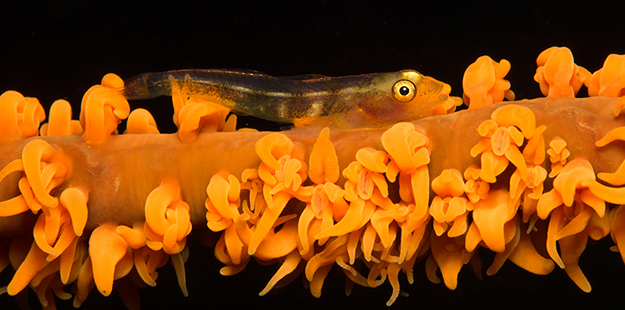
Whip coral gobies hang close to their sheltering branch, nabbing the occasional invertebrate or dollop of zooplankton that drifts past. Photo by Marcus Lindenlaub
In addition to gobies, sea whips play host to a variety of mussels, snails, shrimp and crabs. One of the most interesting finds that sharp-eyed divers can discover at Wakatobi is the xeno crab. These alien-looking crustaceans spend their lives holding on to the stalk of a sea whip, and have adapted to this clinging lifestyle by developing four pairs of long legs–two facing forward and two pointing backwards–which they can wrap all the way around a stalk. Though they can grow to several inches in length, these crabs can be difficult to spot, as they take on the coloring of their host, and grow shells that resemble the spiky texture of the whip’s stalks.
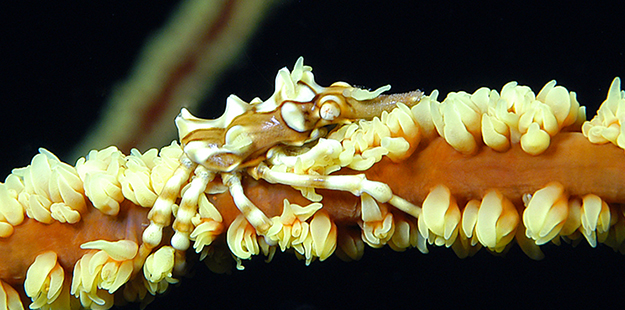
The rare xeno crab spends life on the stalk of a sea whip, wrapping its four pairs of long legs–two facing forward and two pointing backwards–all the way around a stalk. Photo by Wakatobi Resort
A smaller whip coral dweller that also makes for interesting observation and macro portraits are the diminutive wire coral shrimp that can be found crawling among the branches in search of algae and detritus.
Pygmies and feather dusters
Because they feed on things that drift past, many varieties of sea fans form large, leaf-like structures that orient perpendicular to prevailing currents. A number of small animals will perch on the fan’s flat surface to share in the moving feast washing past. The best-known residents of sea fans are the pygmy seahorses. Seldom grown larger than 2cm in size, and cunningly camouflaged, these tiny members of the Syngnathidae family were unknown to science until the late 20th century, and many of the seven known species were not discovered until the early 21st.

Species such as this rare Denise’s pygmy seahorse can’t live without their host sea fan; extreme camouflage that makes them near invisible on the fan would be obvious to predators anywhere else. Photo by Richard Smith
Four of these seven seven species of pygmies are found at Wakatobi, and two, Bargibant’s and Denise’s, live only on very specific types of sea fan. Knowing this provides seahorse hunters with a good starting point, but it still takes a keen eye to locate these tiny creatures, which can be smaller than a fingernail.
Much easier to spot than tiny seahorses are the numerous varieties of colorful crinoids that make their way onto the fans, where they spread feather-duster-like plumes to harvest passing morsels. Crinoids are one of the earth’s oldest surviving creatures, dating back more than 400 million years. When they decide to move about, it can be quite fascinating to watch, but more often, you’ll find them perched in stationary fashion near the outer edge of the sea fan, holding position in the current. Approach a crinoid carefully and look closely, you may discover an assortment of small shrimp, crabs and fish that take shelter within the feather-like arms.
Look closely within a crinoid’s feather-like arms and you may discover an assortment of small shrimp, crabs and fish taking shelter.
Often joining the crinoids are their relatives, the brittle stars. These animals tend to lay flat against the fan, with their long, snake-like arms intertwined with the venous patterns of the host. When feeding, one or more of these arms will be stretched into open water, where small tube feet and feather-like structures are extended to increase the surface area available to capture passing meals. Brittle stars often become more active after dark, and can be an interesting subject during a night dive on the House Reef.
Among the branches
Not all sea fans are flat as a paddle. Some varieties send multiple branches out in all directions, and more closely resemble a bush. In addition to populations of gobies, crabs, seahorses and crinoids, these denser growths provide cover for an even broader menagerie of sea life, including small fish.
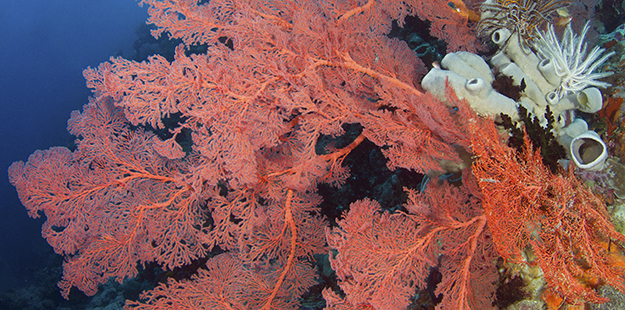
Sea fans can be flat or sprout multiple branches that harbor a variety of life. Photo by Walt Stearns
One unique character that you are likely to find among the branching soft corals of Wakatobi is the longnose hawkfish. Typically 5 to 10 cm in length, these fish have a bright orange and red crosshatch pattern that makes them quite photogenic, but also helps them blend into their surroundings.
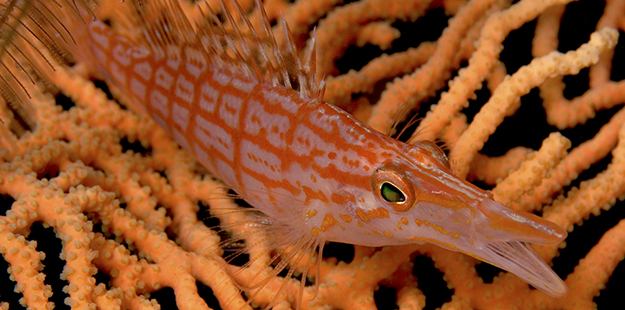
The longnose hawkfish has large pectoral fins, which help them maneuver and perch on sea fan branches. Photo by Wakatobi Resort
You will often find these colorful little fish hovering close to a concealing sea fan branch, waiting patiently for a tasty crustacean to swim within range. When a suitable target is spotted, the hawkfish will swoop in for a quick kill. This hunting style is likely what earned it the association with its namesake bird.
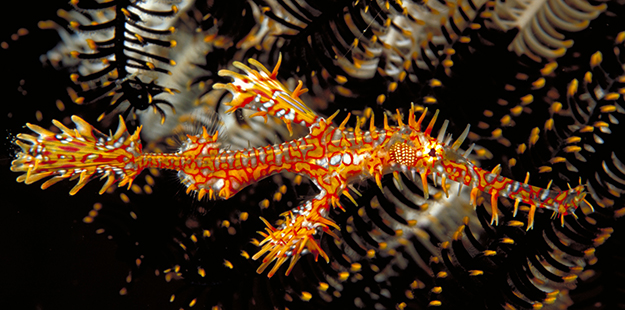
Considered a prized find by many photographers and marine life enthusiasts, the exotic ornate ghost pipefish sport impressive arrays of spike-shaped fins that might mimic the appearance of a crinoid, or a random clump of weed. Photo by Werner Thiele
Another stealthy regular that is a prized find on a Wakatobi soft coral bush is the ornate ghost pipefish, also known as the harlequin ghost pipefish. These exotic creatures sport impressive arrays of spike-shaped fins that sometimes mimic the appearance of a crinoid, or might give the appearance of a random clump of drifting weed. Ghost pipefish are experts at hiding in plain sight. They are equally adept at working with currents and eddies to hold position or drift inconspicuously as they remain motionless, waiting patiently for a meal to come within range. When that happens, the ghost pipefish doesn’t lunge, and instead uses a lightning-fast snap of its elongated snout to create a powerful suction that draws dinner to them.
Closer looks at sea fans will yield additional finds. Juvenile cuttlefish, squid and convict blennies all seek shelter among the branches, as do a wide range of crustaceans and even the occasional nudibranch. So the next time you come across a colorful collection of sea fans or whips on a Wakatobi reef, don’t just swim by. Stop and spend a few minutes discovering the rich diversity of life that lives among the branches.
Discover all the unique marine life and remarkable finds that Wakatobi has to offer. Contact us at office@wakatobi.com or complete a quick trip inquiry at wakatobi.com.
Visit us on Facebook.


